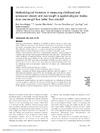Please use this identifier to cite or link to this item:
https://accedacris.ulpgc.es/jspui/handle/10553/44797
| Title: | Methodological limitations in measuring childhood and adolescent obesity and overweight in epidemiological studies: Does overweight fare better than obesity? | Authors: | Serra-Majem, Lluís Ribas-Barba, Lourdes Pérez-Rodrigo, Carmen Ngo, Joy Aranceta, Javier |
UNESCO Clasification: | 32 Ciencias médicas 3206 Ciencias de la nutrición |
Keywords: | Body-Mass Index For-Disease-Control Waist Circumference Spanish Children Growth Reference, et al |
Issue Date: | 2007 | Journal: | Public Health Nutrition | Conference: | 7th Congress of the Spanish-Society-for-the-Study-of-Obesity | Abstract: | Objectives: International definitions of childhood obesity based on body mass index (BMI) are intended to be used for international comparisons of obesity prevalence. In general, they are not appropriate to be used in clinical practice. The objective of this study is to compare international-ecological vs. national-clinical reference data of obesity in Spain, as well as to describe trends.Design: Cross-sectional study from a representative national random sample of Spanish children and youth conducted between 1998 and 2000. Prevalence estimates of obesity in a national random sample of Spanish children and youth are presented in this paper, defined by age- and sex-specific BMI national reference standards for the 85th percentile (overweight) and 95th percentile (obesity), as well as by Cole et al. criteria. The study protocol included personal data, data on education and socio-economic status for the family and anthropometric measurements.Setting: Population-based study set in Spain.Subjects: A random sample of 3534 individuals, aged 2-24 years.Results: Prevalence of obesity using national reference data was higher (15.3%) than using international data (5.8%), but overweight rates were similar. Agreement observed for both definitions was low for obesity but higher for overweight. Obesity trends among children and adolescents in Spain show increasing patterns in boys but not in girls.Conclusions: Results indicate the need to standardise the definitions of obesity and overweight in childhood and recommend the use of overweight due to the greater degree of agreement observed among the different methods used. The IOTF reference method underestimates obesity rates in Spanish schoolchildren. | URI: | https://accedacris.ulpgc.es/handle/10553/44797 | ISSN: | 1368-9800 | DOI: | 10.1017/S1368980007000584 | Source: | Public Health Nutrition [ISSN 1368-9800], v. 10, p. 1112-1120 |
| Appears in Collections: | Artículos |
SCOPUSTM
Citations
15
checked on Jun 8, 2025
WEB OF SCIENCETM
Citations
12
checked on Jun 8, 2025
Page view(s)
50
checked on Sep 7, 2024
Download(s)
114
checked on Sep 7, 2024
Google ScholarTM
Check
Altmetric
Share
Export metadata
Items in accedaCRIS are protected by copyright, with all rights reserved, unless otherwise indicated.
